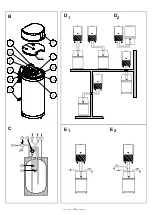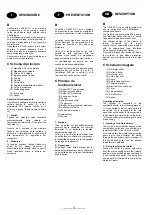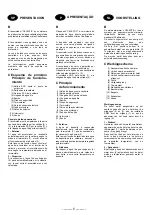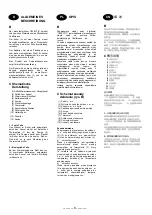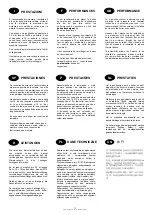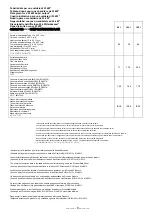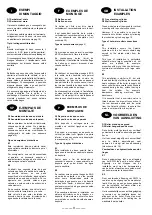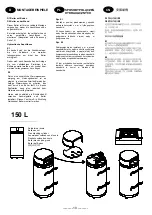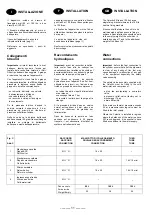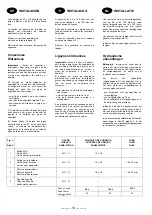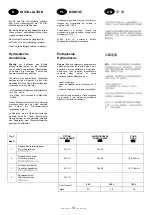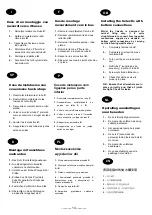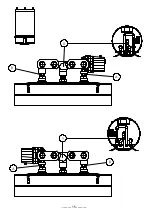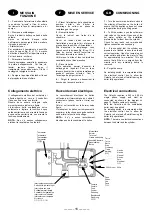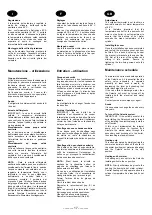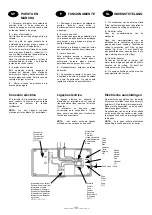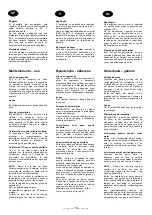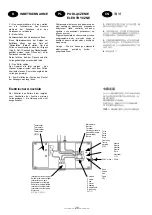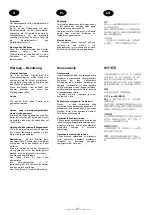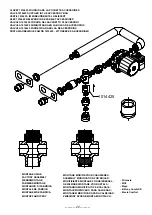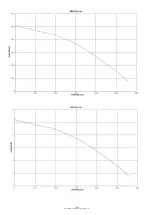
F
Réglages
L’aquatast du ballon est réglé de façon à
obtenir de l’eau chaude sanitaire à 65° C
environ.
Ainsi, sur les chaudières équipées d’une
consigne ECS de 60° C, il est nécessaire
de régler la température de l’eau chaude
sanitaire au maximum, de façon à ce
qu’elle soit supérieure au point de
consigne du thermostat du ballon.
Montage du capot
Une fois l’ensemble monté, placer le capot
de protection en le glissant sous les deux
pattes à l’arrière du ballon et le fixer par
les deux vis sur la virole du ballon.
Entretien – utilisation
Groupe de sécurité
Afin de s’assurer du bon fonctionnement
du groupe de sécurité, il est nécessaire de
faire fonctionner celui-ci au minimum une
fois par mois en actionnant le levier et en
vérifiant que l’eau s’écoule normalement.
Si l’eau ne s’écoule pas, il y a lieu de faire
venir d’urgence un professionnel, après
avoir arrêté l’appareil.
Anode
Il est obligatoire de changer l’anode tous
les deux ans.
Arrêt de l’installation
IMPORTANT : En cas d’arrêt de la
chaudière il est nécessaire de couper
l’alimentation électrique du ballon. Dans le
cas contraire, la pompe ferait inutilement
circuler de l’eau froide dans la chaudière
de façon permanente.
Chauffage sans eau chaude sanitaire
Si on désire avoir du chauffage sans
provoquer le réchauffage du ballon, il suffit
de mettre en route la chaudière en
laissant l’interrupteur du ballon en position
arrêt.
Chauffage et/ou eau chaude sanitaire
Afin d’obtenir de l’eau chaude sanitaitre,
une fois la chaudière en fonctionnement, il
suffit de manœuvrer l’interrupteur du
ballon ce qui provoque le réchauffement
de l’eau contenue dans celui-ci.
NOTA
:
Etant donné la priorité au
sanitaire de la chaudière celle-ci ne
produira du chauffage que lorsque le
ballon aura été réchauffé.
En cas de non utilisation de l’installation
en période froide, il est nécessaire de
vidanger le ballon pour prévenir le gel.
Fermer l’arrivée d’eau du groupe de
sécurité.
Ouvrir le robinet d’eau chaude.
Démonter le raccordement (rep. B) au
ballon.
Placer un raccord type raccord de tuyau
d’arrosage avec un tube caoutchouc.
Vidanger le ballon par siphonnage.
Remonter le raccordement (Rep. B).
I
Regulazione
Il termostato del serbatoio è regolato in
modo da ottenere dell’acqua calda
sanitaria a circa 65° C.
Cosi, conformemente all’istruzione ECS
(acqua calda sanitaria) di 60° C, portata
su alcune caldaie, é necessario regolare
la temperatura dell’acqua calda sanitaria
al massimo in tal modo che essa sia
superiore al punto di consegna del
termostato dello scaldabagno.
Montaggio della cuffia di protezione
Una volta montato l’assieme, piazzare la
cuffia di protezione facendolo scivolare
sotto le due staffe dietro il serbatoio e
fissarla con le due viti sulla ghiera del
serbatoio.
Manutenzione
–
utilizzazione
Cruppo di sicurezza
Al fine di assicurare il buon funzionamento
del gruppo di sicurezza è necessario farlo
funzionare almeno una volta al mese
azionando la leva e verificando che
l’acqua scorra normalmente.
Se l’acqua non scorre, è il caso di far
intervenire urgentemente uno specialista,
dopo aver spento l’apparecchio.
Anodo
E obligatorio il cambiamento di anodo tutti
i due ani.
Arresto dell’impianto
IMPORTANT : In caso di arresto della
caldaia, è necessario interrompere
l’alimentazione elettrica del serbatoio. In
caso contrario, la pompa farà inutilmente
circolare l’acqua fredda nella caldaia in
modo permanente
Riscaldamento senza acqua calda
sanitaria
Se si desidera avere il riscaldamento
dell’impiando sonza riscaldare il serbatoio,
basta accendere la caldaia lasciando
l’interruttore del serbatoio in posizione
spenta.
Riscaldamento
ed
acqua
calda
sanitaria
Al fine di ottenere l’acqua calda sanitaria,
una volta messa in funzione la caldaia,
basta ma novrare l’interrutore del
serbatoio, il che provoca il riscaldamento
dell’acqua in esso contenuta.
NOTA
: Data la priorità all’impianto
sanitario della caldaia, essa non proddurà il
riscaldamento dell’impianto fino a quando
l’acqua contenuta nel serbatoio non ha
raggiunto la temperatura fissata con il
termostato. In caso di non utilizzazione
dell’impianto in periodo freddo, è
necessario svuotare il serbatoio per
prevenire il gelo. Chiudere l’arrivo d’acqua
del gruppo di sicurezza. Aprire un rubinetto
d’acqua calda. Smontare il collegamento
(Rep. B) al serbatoio. Piazzare un raccordo
del tipo tubo d’innaffiamento con un tubo di
gomma. Svuotare il serbatoio mediante
travasamento. Rimontare il collegamento.
GB
Adjustments
The cylinder thermostat is set to obtain a
nominal domestic hot water temperature
of 65° C.
It is therefore important that the
temperature control for the domestic hot
water, on the boiler, is set to maximum to
ensure that the delivery of hot water
exceeds the mean temperature of the
cylinder.
Installing the cover
Once the installation has been completed
and tested, the protective cover can now
be fitted. This is done by placing it under
the bracket (or brackets in the case of the
150 ltrs) at the rear of the cylinder and
sliding it into position. Secure by
tightening the two fixing screws onto the
cylinder.
Maintenance schedule
To maintain the correct and safe operation
of the Celectic unit, it is essential that the
safety valve assembly is operated
manually at least once a month, by
depressing the lever and checking that
water discharges from the valve.
If the valve fails to discharge water, then
the Celectic unit must be turned off by
isolating both the electrical and water
supplies.
Contact your service company or agent.
Anode
It is necessary to change the anode every
two years.
To turn off the Celectic system
IMPORTANT : If the unlikely event of the
boiler failing, the Celectic should be turned
off by isolating the electrical supply via the
on/off switch.
If this is not implemented the integral
pump will continue to function and
circulate the stored water through the
secondary heat exchanger in the boiler,
thus resulting in stand-by losses.
Heating only
This can be achieved by simply setting the
summer and winter switch on the boiler to
the winter position (hot water and heating)
and the Celectic switch to the stop
position.
Heating and hot water
As heating only, except turn the Celectic
isolating switch to the on position.
NOTA
: Priority will always be given to the
heating the domestic hot water cylinder.
Central heating will only operate once the
cylinder temperature has reached its set
level.
________
1
7
________

